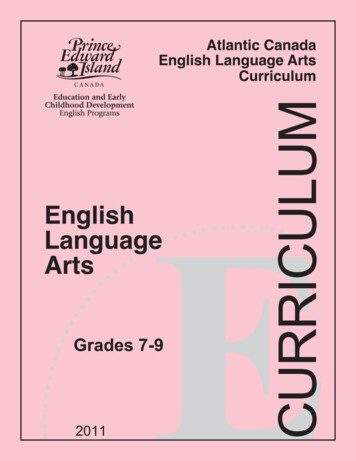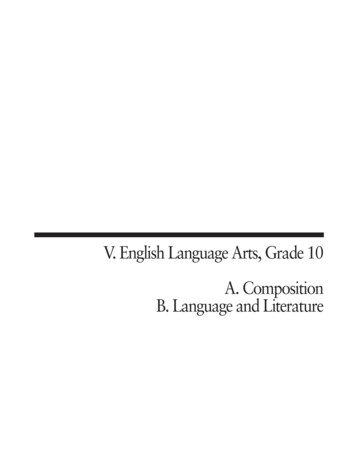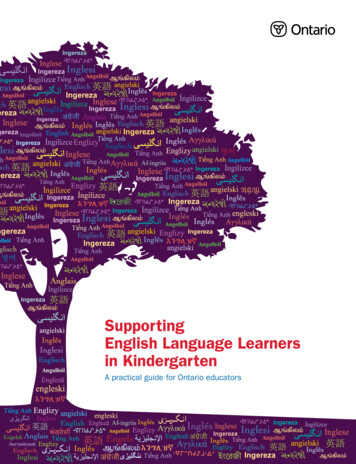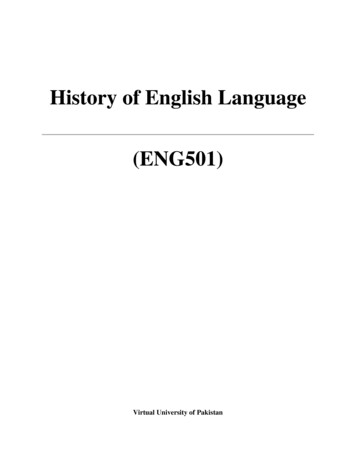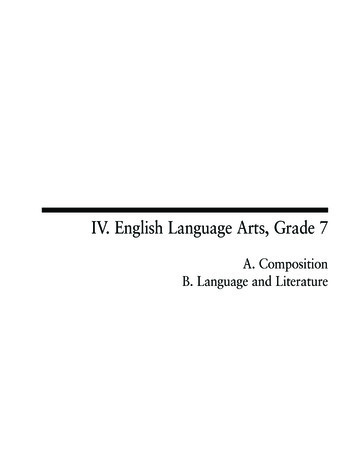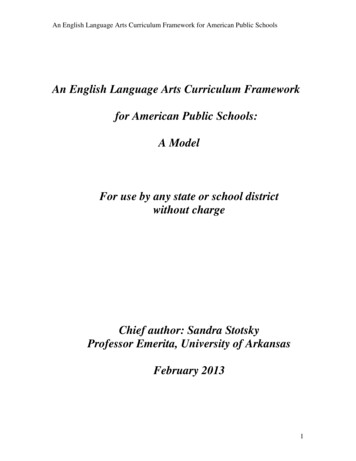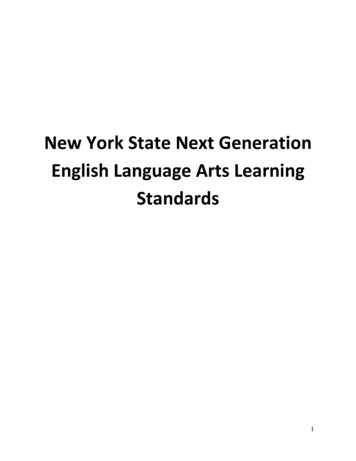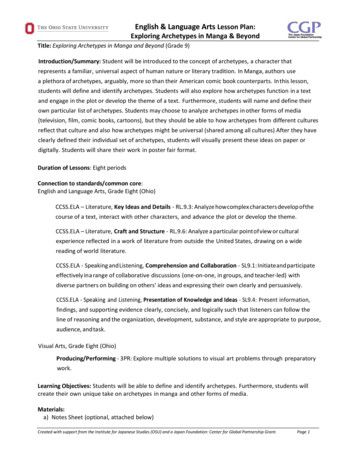
Transcription
English & Language Arts Lesson Plan:Exploring Archetypes in Manga & BeyondTitle: Exploring Archetypes in Manga and Beyond (Grade 9)Introduction/Summary: Student will be introduced to the concept of archetypes, a character thatrepresents a familiar, universal aspect of human nature or literary tradition. In Manga, authors usea plethora of archetypes, arguably, more so than their American comic book counterparts. In this lesson,students will define and identify archetypes. Students will also explore how archetypes function in a textand engage in the plot or develop the theme of a text. Furthermore, students will name and define theirown particular list of archetypes. Students may choose to analyze archetypes in other forms of media(television, film, comic books, cartoons), but they should be able to how archetypes from different culturesreflect that culture and also how archetypes might be universal (shared among all cultures) After they haveclearly defined their individual set of archetypes, students will visually present these ideas on paper ordigitally. Students will share their work in poster fair format.Duration of Lessons: Eight periodsConnection to standards/common core:English and Language Arts, Grade Eight (Ohio)CCSS.ELA – Literature, Key Ideas and Details - RL.9.3: Analyze how complex characters develop of thecourse of a text, interact with other characters, and advance the plot or develop the theme.CCSS.ELA – Literature, Craft and Structure - RL.9.6: Analyze a particular point of view or culturalexperience reflected in a work of literature from outside the United States, drawing on a widereading of world literature.CCSS.ELA - Speaking and Listening, Comprehension and Collaboration - SL9.1: Initiate and participateeffectively in a range of collaborative discussions (one-on-one, in groups, and teacher-led) withdiverse partners on building on others' ideas and expressing their own clearly and persuasively.CCSS.ELA - Speaking and Listening, Presentation of Knowledge and Ideas - SL9.4: Present information,findings, and supporting evidence clearly, concisely, and logically such that listeners can follow theline of reasoning and the organization, development, substance, and style are appropriate to purpose,audience, and task.Visual Arts, Grade Eight (Ohio)Producing/Performing - 3PR: Explore multiple solutions to visual art problems through preparatorywork.Learning Objectives: Students will be able to define and identify archetypes. Furthermore, students willcreate their own unique take on archetypes in manga and other forms of media.Materials:a) Notes Sheet (optional, attached below)Created with support from the Institute for Japanese Studies (OSU) and a Japan Foundation: Center for Global Partnership Grant.Page 1
English & Language Arts Lesson Plan:Exploring Archetypes in Manga & Beyondb) Archetype Examples lists (attached)c) Examples of Final Project (attached)d) Examples of MangaLesson Activity Day 1Define the term 'archetype'. Ask students if they can think of any examples of archetypes from theirfavorite stories (movie or television stories or books). Next, ask students to get in small groups.Provide students with the list of archetype from various resources. Ask the students to record some or all ofthe archetypes on their notes sheet. If time permits, discuss with students the functionality andappropriateness of these archetype labels.Lesson Activity Day 2Ask students to take out their notes from the previous class. Individually or in small groups, providestudents with manga examples. The examples could be borrowed from a classroom, school, or publiclibrary. Teachers may also allow students to bring in their own examples making sure to preview theexamples first. Ask students to peruse the manga titles for examples of the archetypes they recorded ontheir notes. It might be helpful to allow students to trade titles after five minutes or so.Lesson Activity Day 3Ask students to share some of their findings from previous classes. During the discussion, the teachershould point out both the overlapping descriptions and the multitude of different types of archetypes.After students share, ask students whether it was difficult to identify examples of these specificarchetypes. At this point, the teacher should introduce the final project. Show the provided example orcreate a new example to show. Use some examples to explore what these archetypes say about theculture from which they come. Ask students to begin devising their own labels and characteristics forarchetypes. Students may be encouraged to think about archetypes in other mediums and cultures atthis point.Lesson Activity Day 4Ask students to brainstorm descriptions and labels for their archetypes individually. After studentshave a few examples, ask them to get into small groups. To promote individuality and creativity,instruct each member in each group to come up with unique theme to their labels. Different themescould include humorous labels, "The Dumb Boy Next Door'', ironic labels "Not Quite Prince Charming",question labels, "When am I getting rescued?", or even labels that all begin with the same letter orshare some other common feature. Ask students to have their creative labels ready for next class.Lesson Activity Day 5Students should be able to identify and discuss how archetypes function in a story. Ask students totake out their notes and creative labels from last class. Individually or in small groups, providestudents with manga examples, again. This time, ask students to peruse the manga titles for examplesof the archetypes they invented. If students have trouble finding examples, ask students to considerchanging their descriptions. Once students identify examples, students can share their findings in smallgroup for informal feedback on their archetype labels. Ask students to have their field tested creativelabels ready for next class.Lesson Activity Day 6Review the final project visual with students. Provide students with scrap paper to begin sketching outtheir visual aide depicting their archetype labels. Encourage students to come up with two or threeCreated with support from the Institute for Japanese Studies (OSU) and a Japan Foundation: Center for Global Partnership Grant.Page 2
English & Language Arts Lesson Plan:Exploring Archetypes in Manga & Beyonddistinctly different examples. Remind students they do not need to be artistically inclined as they canuse shapes and color to represent their archetypes. If students have access to technology, student mayopt to digitally design a visual aide. At some point, students may want to share examples withclassmates before settling on their final design.Lesson Activity Day 7Students should have their revised labels and visual aid design. Students should begin working on theirfinal project in class. Teachers should be sure to provide informal feedback throughout class.Lesson Activity Day 8Students should formally submit their final visual aids for formal teacher feedback.Lesson Activity Day 9After students have formal teacher feedback and have being given time to make final revisions, theteacher will conduct a Pair/Share/Fair. This is a format in which student will take their visual aids andpair up with a partner, sitting next to each other. The two will designate who will share first andsecond. There will be two rounds of sharing. One student will post his or her visual aide somewherein the classroom and answer questions as his or her partner walks around the room and views otherstudents' work. At a certain time, the partners will trade. If possible, all posters should be displayed atonce. For an exit slip activity, ask students to pick one archetype, not one of their own, and describe howthat reveals one aspect of the culture from which it comes (example: the spoiled rich kid archetype showsthat while Americans value wealth, people who have it are sometimes crude).Lesson plan written by: Chevy Sidel, National Board Certified Teacher, Bexley Middle School, ColumbusOhioCreated with support from the Institute for Japanese Studies (OSU) and a Japan Foundation: Center for Global Partnership Grant.Page 3
ArchetypesBy RioArchetypes? Yes, archetypes. Unlike stereotypes which are generalized personality types, archetypes areuniversal characters that have mass recognition across any culture. In this article, I'll be talking about universalcharacter archetypes plus taking that archetype and making it "manga".Universal archetypes have seven basic archetypes with a select few more often used and familiar than others.These archetypes does not necessarily have to be human. They can be animate or inanimate, animals or aliens,young or old. I'll be addressing the "Hero" as a "he" to save on any h/she, his/her semantic. The 7 Archetypesare: Hero - The protagonist of the story. Usually courageous, a leader, righteous, and determined. Goku fromDragon Ball Z, for example, fits the Hero mold. Mentor - As the name suggests, Mentors take on the role of teacher and guide the hero to become morethan what he was to fulfill his quest. A Mentor would be Luna from Sailor Moon. Threshold Guardian - An adversary who tests the courage, strength, intelligence, or other trait of the hero butis not the main villain nor the villains underlings. Since no manga threshold guardian comes to mind, RPGs arefilled with threshold guardians whom you have to battle first before they help you. Herald - A herald is someone who says what the hero has done or carries messages for the hero.Unfortunately, no herald archetype comes to mind in manga. Shapeshifter - The one who is not what he seems on the outside. Typical shapeshifters are double agents, andthose with private motives. Haku from Spirited Away, for instance, is a shapeshifter in multiple levels. For one,he aids Chihiro but he is Yubaba's "henchman" and for another, at first glance, he appears to be human butthat is proved otherwise in the end. Shadow - The dark side of our personality. The shadow is the villain that must be overcome whether it iswithin another or within the hero himself. Shadow-types include Kenshin as the Battousai in Rurouni Kenshinand it's recurring temptation to manifest itself once again. Trickster - Mischievous and often humorous characters whom the hero cannot rely on as the trickster tendsto act unpredictably such as switching sides. Xellos of Slayers is a well-known trickster who aids hiscompanions but makes some moves that are erratic.These universal archetypes may be mixed together such as a Mentor and Trickster. Not only that, archetypesmust become realistic with a semblance of their history, actions, and reactions to situations. Even theirmanner of speech from drawling, accents, slang, and so forth becomes a part of who they are.The funny thing about manga is that they bend the rules. Hero's for instance, may have a quirk from beingdomestically challenged (ex/ can't cook to save their life) to being physically impaired (ex/ changes into a girlwith a mere splash of cold water) that foils the traditional "hero" ideal. This, though, is what makes mangapersonable than other stories - readers can relate to those imperfections.From http://resoo.org/www/bd/manga/tut/archety Q.es.htm
Common MangaArchetypes ByKensuke OkabayashiPart of the Manga For Dummies Cheat SheetThe type of Japanese comics or cartoons called manga has its archetypes - classic examples of the art- just like every other art form. The archetypal characters and plots you encounter in manga generallyfall into one of four categories:The Good Guys The Androgynous Rookie (main lead): He's the new kid on the block who's full of energy and promise.He usually has an androgynous face and hairstyle. The Sidekick: He, she, or it is the young rookie's best pal. The two go hand-in-hand and rarely gothrough a complete manga story by themselves. The Caring Female: She's the only main, featured female who represents the maternal caregiver andis always around to give emotional support to the young rookie. The Veteran: He's the experienced character. He's not necessarily the strongest, but he has a lot ofwisdom and makes sure the young rookie is in check with reality. The Loyal Geek: What he lacks in muscle, he makes up in intelligence and loyalty. He's the one whostays back at the home base crunching numbers to make sure the team wins. The Backup: This guy is pure muscle, which makes him the ultimate backup. He's not the sharpesttool in the shed, but he'll use his dominating physical presence to help the team. The Wise One: He's the sage mentor who's been around for what seems like forever.The Bad Guys The Handsome Icy Villain: This type is cunning, deceitful,and drop-dead gorgeous. His attire is simple- he wears a dark cape, but the rest of his costume is one plain color. The Evil Sorceress: She's clad in dark armor and a bikini,with a dark cape flowing behind her. Withher evil magic, there's no telling what demonic plan she has in mind. The Awesome Warrior: This handsome and muscular giant relies on his strength to get the job done.In addition to a cape, he never leaves without his elaborate armor. The Military Vixen: This lady takes down anyone in charge to get power for herself. She'sbeautiful,but her dark attire and evil smile are giveaways that you don't want to be near her.
Damsels in Distress The "Little Sister" Princess: Picture a younger sister getting in trouble by sticking her nose in otherpeople's business. The main character has little choice but to go in and bail her out. The Innocent School Girl: She endures harsh treatment at the hands of her captor while the leadcharacter devises a daring way of rescuing her. Don't worry, she never dies (that would kill the plot). The Loyal, Selfless Damsel: Compared to the Innocent School Girl,this damsel controls her emotions.Despite being tortured, she remains calm and loyal to her team.Shojo Manga The Rags-to-Riches Girl: Once a commoner or an orphan, this girl is now living a better life. She has tofend off other jealous girls while she tries to capture the heart of her charming prince. The Knight in Shining Armor: This gentleman is a handsome dream for any teenage girl. He's flawlessin every aspect, and any girl can come to him for help or common-manga-archetypes.html
Aquavinn's Crystaline CastleAnime ArchetypesHere's proof that I actually think about this stuff!An archetype (according to Webster's Ninth New Collegiate Dictionary) is an inherited idea or mode ofthought in the psychology of C.G. Jung that is derived from the experience of the race and is present inthe unconscious of the individual. Perhaps they meant subconscious. Anyway, every country andculture has its own unique set of archetypes. Simply put, they are types of characters and situationsthat are repeated in plots. Some examples of universal archetypes are the Hero, the Fallen Angel, theWise Old Woman and the Star-Crossed Lovers.Traditional Archetypes The Hero-A young adult (usually) that must overcome a series of challenges to solve a problem.Once the goals are met, the Hero is mentally and spiritually reborn. Examples: Little Foot from"The Land Before Time," Mulan from "Mulan" (duh), Neo from "The Matrix." The Fallen Angel-A benevolent character that has fallen from grace (or is accused of doing so)and must overcome many challenges to regain his/her honor. Examples: The Fugitive,.! knowthere are more.if you think of any, email me! The Wise Old Woman-An elderly woman with great wisdom. She displays deep kindness and lovetowards the Hero. Sometimes she has mystical or spiritual powers. Examples: The Nurse fromRomeo and Juliet, the Fairy Godmother from almost every fairy tale with a female hero. The Star-Crossed Lovers-Two people that care immensely for each other but due to theircircumstances or positions in society, can never be together. Examples: Romeo and Juliet, Jim andHuck (hey, the definition didn't say they were in love. If you've read Huck Finn, you probablynoticed that Jim and Huck were like father and son; so it goes).I have watched a lot of anime and played many RPG's in my 18 years of existence, and I have noticed adefinite set of archetypes for these. **! include RPG's because most are based on manga, as are mostanime. Also, RPG's often have anime made of them or vice versa. **Here is a list of anime archetypes Ihave discovered:Anime Archetypes The Long-Haired Fallen Angel-A herioc figure who has fallen from grace and despite beingscorned for his fall, still remains honorable. This archetype is usually male and has very distinctivelong, flowing hair that hangs mid-back or longer. He tends to bear a sword and is also fond ofwearing long capes and coats. The Cool Old Guy with Scars-An elderly and wise man from whom the Hero has learned valuablelessons. He usually dies at the beginning of the plot, thus shoving the total responsibility on the
not-quite-ready Hero.The Goth Guy with One Metal Arm-A tall, dark, mysterious man with a robotic arm. He, like theLong- Haired Fallen Angel, has great honor, but there is something eating him up inside. Most GothGuys with Metal Arms have had their heart cruelly broken, or something similarly traumatic. They,like Long-Haired Fallen Angels, are also fond of wearing long capes or coats.anything that blowsdramatically in the breeze. The Magical Teen-An oblivious young person that gains special powers for no particular reason.Later it is discovered that the Magical Teen's powers stem from their lineage, or reincarnation.Magical Teens are usually females attending junior high or high school. They often have sidekicks and a whole mess of nifty little magic devices to help them out. They also seem to beseverely troubled in the area of romance. The Smart-alee American-This character is known for being, well.a character. As in he constantlyticks people off, makes reckless mistakes, has a big ego and still somehow manages to be perfectlypopular. He is prone to having pony-tail hair and a Leno-esque chin--that needs a shave. He's notliterally American, but he displays that go-getter, nothing-can-stop-me attitude that isstereotypically tagged onto U.S.characters. There is, however, a more hidden part of this character. He has iron-clad honor and aheart of gold, and it the only part of his persona that he doesn't flaunt. Personal note: I really likethis archetype. If my dad was ever made into an anime character, he would be one of these guys. Little Miss Violence-A troubled young woman .she's hurt, angry, and confused about her place inlife. She also has a talent for kicking butt. In order to forget her problems, she fights. She has agood cause, but fighting does not satisfy her. It only distracts her from her other problems,making her push them farther down. An anguished but lovable character.From http://www.angelfire.com/ani me/TaigaRa/animearchetypes.html
Name----DateUnderstanding ArchetypesNotes SheetDefining ArchetypeWhat is an archetype? Define this term in the space below.Can you think of an archetype in the stories you read or watch? List below.Genre/MediumTitleArchetypeReviewing Examples of ArchetypesUsing one of the sheets provided by your teacher, write down examples of archetypes byrecording the name of the archetype and a short description of the characteristics of thatarchetype.ArchetypeDescription
Name -------DateUnderstanding ArchetypesNotes SheetIdentify Examples of ArchetypesUsing your list on the previous notes, identify examples of archetypes by recording thetitle of the book, the name or description of the character, and the archetype label fromyour notes.Define Your Own Examples of ArchetypesUsing your list on the knowledge of archetypes, create your own labels and descriptionof archetypes.ArchetypeDescriptionUse this space for your final labels. These should be themed, creative, and unique.
that reveals one aspect of the culture from which it comes (example: the spoiled rich kid archetype shows that while Americans value wealth, people who have it are sometimes crude). Lesson plan written by: Chevy Sidel, . In this article, I'll be talking about universal character archetypes plus taking that archetype and making it "manga".


